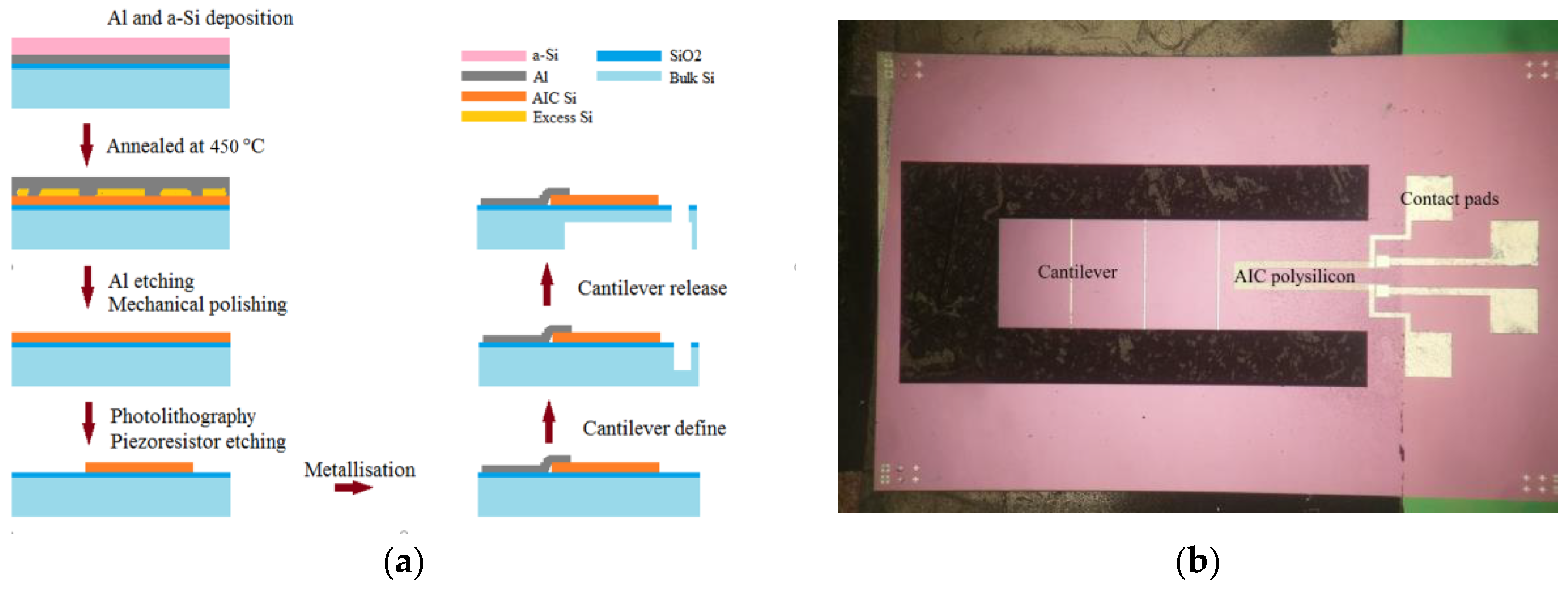High Gauge Factor Piezoresistors Using Aluminium Induced Crystallisation of Silicon at Low Thermal Budget †
Abstract
:1. Introduction
2. Experiment
3. Results and Discussion
4. Conclusions
Acknowledgments
Conflicts of Interest
References
- Nast, O.; Wenham, S.R. Elucidation of the layer exchange mechanism in the formation of polycrystalline silicon by aluminum-induced crystallization. J. Appl. Phys. 2000, 88, 124–132. [Google Scholar] [CrossRef]
- Uhlig, S.; Rau, S.; Schultes, G. Piezoresistivity of polycrystalline silicon applying the AIC process-route. Sens. Actuators A Phys. 2011, 172, 447–454. [Google Scholar] [CrossRef]
- Patil, S.K.; Çelik-Butler, Z.; Butler, D.P. Piezoresistive polysilicon film obtained by low-temperature aluminum-induced crystallization. Thin Solid Films 2010, 519, 479–486. [Google Scholar] [CrossRef]
- French, P.J.; Evans, A.G.R. Piezoresistance in polysilicon and its applications to strain gauges. Solid State Electron. 1989, 32, 1–10. [Google Scholar] [CrossRef]




| Doping | Intrinsic | 2 × 1018/cm3 |
|---|---|---|
| Sheet Resistance [Ω/sq] | 686 | 840 |
| Doping | Intrinsic | 2 × 1018/cm3 |
|---|---|---|
| Gauge Factor | 52 | 62 |
Publisher’s Note: MDPI stays neutral with regard to jurisdictional claims in published maps and institutional affiliations. |
© 2017 by the authors. Licensee MDPI, Basel, Switzerland. This article is an open access article distributed under the terms and conditions of the Creative Commons Attribution (CC BY) license (https://creativecommons.org/licenses/by/4.0/).
Share and Cite
Chuang, I.; Michael, A.; Kwok, C.Y. High Gauge Factor Piezoresistors Using Aluminium Induced Crystallisation of Silicon at Low Thermal Budget. Proceedings 2017, 1, 354. https://doi.org/10.3390/proceedings1040354
Chuang I, Michael A, Kwok CY. High Gauge Factor Piezoresistors Using Aluminium Induced Crystallisation of Silicon at Low Thermal Budget. Proceedings. 2017; 1(4):354. https://doi.org/10.3390/proceedings1040354
Chicago/Turabian StyleChuang, Ian, Aron Michael, and Chee Yee Kwok. 2017. "High Gauge Factor Piezoresistors Using Aluminium Induced Crystallisation of Silicon at Low Thermal Budget" Proceedings 1, no. 4: 354. https://doi.org/10.3390/proceedings1040354




